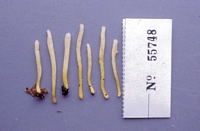|
 Clavaria novozealandica Clavaria novozealandica
BiostatusPresent in region - Indigenous. Endemic
Images (click to enlarge)
Caption: Fig. 15 Clavaria novo-zealandica, spores, TENN no. 43578. Scale bar = 5µm. | 
Caption: Microfiche 1-7. Clavaria novo-zealandica. TENN no. 43575. |
Article: Petersen, R.H. (1988). The clavarioid fungi of New Zealand. New Zealand Department of Scientific and Industrial Research, Bulletin 236: 170 pp. Wellington:.
Description: Fruiting bodies up to 50 x 6 mm, clavate, simple clubs, often sulcate or weakly and
irregularly undulate over the hymenium. Stipe up to 20 x 4 mm, solid, with no mycelial pad,
bright yellow at base ("light cadmium"), brighter golden yellow upward ("primuline-yellow",
'"apricot-yellow"), terete to subterete. Club pale yellow to cream ("maize-yellow", "baryta-yellow",
"massicot-yellow", "cream-color") on hymenium, broadly to moderately rounded
apically, fleshy; hymenium appearing waxy; flesh whitish within, brighter yellow than
hymenium just below hymenial surface. Odour faintly fresh to negligible; taste negligible.
Macro chemical reaction: FCL = negative
Tramal hyphae of club generative, hyaline, clamped, thin-walled, of two types; (i) 4-9 µm
diam., straight, somewhat inflated, of elongate barrel-shaped cells; and (ii) 1.5-2.5 µm diam.,
meandering, often anastomosed in "H''-connections. Subhymenium extensive, of tortuous
hyphae 1.5-2.5 µm diam. Hymenium thickening; basidia 40-80 x 8-11 µm, clavate, clamped;
contents scattered-multiguttulate when mature; sterigmata 4, up to 10 µm long, stout,
straight, divergent.
Spores 5.0-5.8(6.5) x 5.0-5.4 µm (E = 1.00-1.20; Em = 1.05; Lm= 5.58 µm), globose to
subglobose, hyaline, thin-walled; contents homogeneous to massively uniguttulate, the
guttule refringent under phase contrast; hilar appendix abrupt, narrow, papillate.
Notes: As explained in the introduction to subg. Clavulinopsis, Clavaria novo-zealandica is a
member of a pair of taxa which produce inflated, clavate fruit bodies, reminiscent of highly
reduced agarics, rather than the usual cylindrical or narrowly fusiform fruit bodies usually
associated with the genus. The other member is Clavaria sulcata. From it, C. novo-zealandica is
easily distinguished by its golden yellow stipe and creamy club.
Sterigmata, as in the other similar taxa, are very stout, straight and divergent, and basidia are
persistent after spore discharge. Basidial length is extremely variable, but this may be a
function of their time of production and/or elongation in the thickening hymenium.
The only taxon likely to be confused with Clavaria novo-zealandica is C. luteostirpata
(q.v.), but although fruit body stature and colour are similar, there is no tendency toward fruit
body inflation in C. luteostirpata. Moreover, the spores of the latter are elongate, and tramal
hyphae are clampless.
Dried specimens are impossible to distinguish macroscopically from other similar taxa, for
all become more or less fleshy ochre and resemble diminutive fruit bodies of
Clavariadelphus pistillaris Linn.: Fr. Squash mounts in 2% KOH remain unchanged in
colour, or are slightly greenish yellow, whereas mounts of C. amoena turn bright golden
yellow, but the two taxa are also separable on spore shape.
|